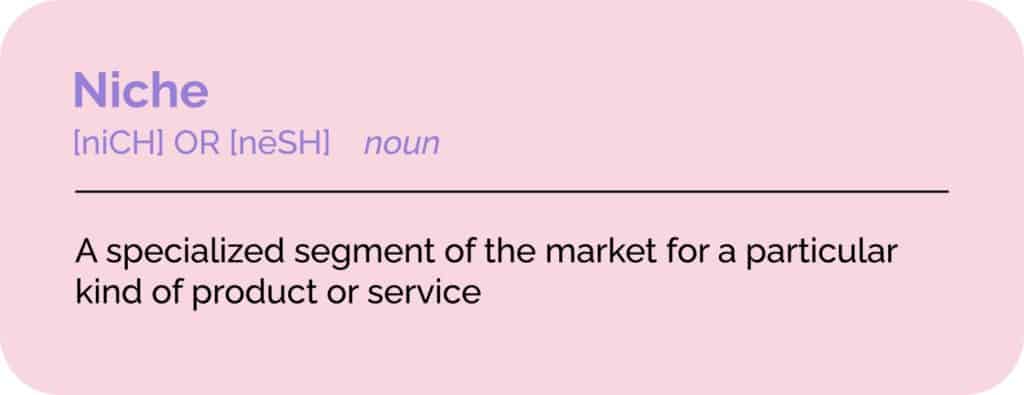You’re walking through the city when you spot a cool new bakery that’s crowded with people. As you step inside, you notice that each of the pastry offerings is either gluten-free or vegan. While the bakery’s options may seem limited on the surface, its high volume of customers shows that they are successfully targeting their niche market.
But What Is a Niche?
A niche is defined as a “specialized segment of the market for a particular kind of product or service.” Whether you pronounce it “Neesh” or “Nich” (how the heck do you say this word?), it is an important concept for marketers to employ in their B2B marketing strategies.
Niche
[niCH] OR [nēSH] noun
A specialized segment of the market for a particular kind of product or service

If businesses focus on a smaller set of customers with specialized needs, they can become the best at what they do in the market. Rather than offering every sort of cake and cookie, this imaginary bakery finds its success with customers who have a specific desire for gluten-free and vegan alternatives.
What is Niche Marketing?
Niche marketing is a type of marketing strategy in which a business focuses on a specific, narrow segment of the market. This can be based on factors such as demographics, interests, or location. The goal of niche marketing is to target a specific group of consumers who are most likely to purchase a product or service, and to tailor marketing efforts specifically to that group. By focusing on a particular niche, a business can differentiate itself from its competitors and better meet the needs of its target market. This can help the business build brand loyalty and increase sales.
To break it down, niche marketing allows brands to:
- Establish a unique brand identity.
- Build customer loyalty.
- Become a leader in their industry.
- Improve the quality of their specific product.
Of course, there are criticisms of niche marketing strategies. Some marketers argue that if a business becomes too specialized, it can grow too dependent on a single product or service. If this product is a passing trend, it could cause sales to decline once its time in the spotlight has ended.
Another concern is that focusing on one niche may isolate a separate niche audience, which would otherwise also enjoy your services.
How Niche Marketing Can Be Valuable for Your Business
A successful niche marketing strategy finds the balance between targeting the right customers and still being accessible to a wider demographic.
Niche marketing can be valuable for a business in several ways:
- Increased profitability: By targeting a specific, well-defined market, a business can better meet the needs of its customers and increase sales and profitability. Because the marketing efforts are more focused, a business can also achieve better results with fewer resources.
- Stronger customer relationships: By focusing on a specific niche, a business can build stronger relationships with its customers. This is because customers in a niche market tend to be more passionate about the products or services they are interested in, and are more likely to be loyal to a business that meets their specific needs.
- Competitive advantage: By focusing on a specific niche, a business can differentiate itself from its competitors and establish a unique brand identity. This can help the business to establish a competitive advantage and attract customers who are looking for a specific product or service.
- Cost Savings: Targeting a specific market can allow a business to more efficiently use its resources. By focusing on a niche market, businesses can lower their marketing costs, which will lead to more efficient use of resources and increased profitability.
- Better understanding of your customers: By targeting a specific market, businesses can gather more accurate and specific information about their customers’ needs, preferences, and behaviors. This will help businesses to create products and services that are tailored to their customers’ specific needs, which can ultimately lead to increased customer loyalty and sales.
- Scalability: Some niche markets are small but have high growth potential, that means, the business can scale up once it has established a reputation and customer base in the niche market.
Your business should continue growing—not become stagnant. Luckily, Zen is here to help! Let’s go over some tips and tricks for how to find your target audience, align your messaging, and stand out from the crowd.
We call this the “5-R” Method!
The “5-R” Method
Finding your niche is a journey, but we’ve got you covered. Our team at Zen Media is happy to share with you our “5-R” Method:
- Review your interests, passions, and desires.
- Resolve your customers’ problems.
- Research competitors in your market.
- Run tests.
- Refine your niche.
Let’s take it one step at a time.
Review Your Interests, Passions, and Desires
The journey to finding your niche market begins with you. Take some time to reflect on what you are most passionate about when it comes to your business. Is there a key product or offering you are most excited about? What makes your company unique? What are you looking to accomplish in the next year—or five years?
Answering these questions will help lead you to your niche market. If you are passionate about something, it’s highly likely that others will be too—those are the people that you will connect with and will become your core audience. They will make up your niche. You just have to do some digging to figure out what your specialty is.
Resolve Your Customers’ Problems
Now that you’ve reviewed your passions, it is time to focus on your customers. In your particular industry, are there any recurring problems that your buyers are facing? How does your business fill a gap and meet the needs of your target market?
To resolve your customers’ problems, you need to analyze and create buyer personas. Buyer personas are detailed descriptions of individuals who represent your target audience. While these are fictional people, writing these descriptions can help you learn about what your niche market is.
Check out this example buyer persona:
Research your potential buyers’ demographics, their interests, and the challenges they face every day. Analyze their buying behaviors and the things they like and dislike. The more specific you are, the easier it will be to find solutions for your customers. The goal is to add value to the market with the unique products that you offer.
Research Competitors in Your Market
Before you claim your niche market, research your competition. Analyzing the target market and strategies of competitors in the same niche can provide valuable insights into customer preferences and trends.
You want to make sure that the market is not overly-saturated with other businesses trying to do the same things that you are. Luckily, platforms like Google Trends can help you investigate your chosen niche like a superspy. These tools can help you identify what your buyer personas are typing into their search engines and if there are any businesses already meeting their needs.
If you find too many businesses competing in the same niche market, go back to the first “R” step and narrow down your ideas. Is there any way for your niche market to be more specific? Or, can you solve another recurring problem?
If data suggests that there is a gap in the market, move forward to the next “R”: Run tests.
Run Tests
You are the lead scientist in your business’ laboratory. Put on your safety goggles because it is time to run some tests.
Before producing your specialty products on a large scale, begin offering them to a smaller group of your target audience first. You can offer a free trial of your services, run paid ads, or even send surveys to your newsletter list. The more data you can directly receive from your customers, the better.
Not only will these tests help you find your niche, but they will also save your business money. You want to make sure that you’ll gain a positive ROI by targeting your niche market. Listen to your customers’ feedback and tweak your business’ offerings until they’re just right.
Refine Your Niche
The last step to finding your niche is refining your ideas. Look back at the “5-R” Method and see if there are any more ways you can establish a unique brand identity. Make sure that your passions still align with the interests of your customers. You should also examine your product’s overall profitability.
Once you’ve completed this step, you are good to go. Say hello to your new niche market!
Niche Marketing Strategies
Now that you’ve learned how to find your niche, it is time to create a marketing plan. Niche marketing strategies can help build customer loyalty as well as your business’ positioning in your industry.
Here are some great marketing tactics to start strengthening your relationship with your niche market:
Email Segmentation
Email segmentation is the ability to divide your email lists into smaller groups. It is a great way to tailor your messaging to specific audiences. Instead of sending one large email with general information about your company, create more specific emails that address your customers’ specific needs and interests. Mailchimp reports that segmented emails have a 14.31% higher open rate than non-segmented emails. It is a great way to build more personal connections with potential buyers and, hopefully, increase conversions.
Related reading: The Ultimate Guide to B2B Email Marketing – Zen Media
Using Niche Hashtags
When making social media content for your business, make sure you are promoting it to the right people. To do this, choose hashtags that are relevant to your niche. One commonly used strategy is to mix niche hashtags with a few popular hashtags. For example, Maggie Schneider, a TikTok musician, typically chooses 1-2 general hashtags and 2-4 niche-specific hashtags per post. This helps her target her fans, those similar to her fanbase (who may be inclined to join her fanbase), as well as the general public.
Related reading: How To Hashtag Like A Pro – Zen Media
Communicating in Niche-Market Groups
Striking up conversations in social media groups is a great way to engage prospective customers. Facebook groups and Discord channels are examples of platforms where users with similar interests and hobbies can come together and connect on their passions.
Related reading: Discord: What Is It and How Can You Use It For Marketing? – Zen Media
Who says that companies can’t join in on the fun? Do some research on where your niche market likes to converse online. Join some private groups and get to know your market first-hand. Or, go ahead and create your own group! This strategy builds relationships and also helps you manage your community.
Related reading: The Ultimate Guide to Community Management For Marketers – Zen Media
Refining Niches: A Case Study
Both new and existing companies should reevaluate their digital campaigns consistently. Businesses need to freshen up their strategies as the market changes and new competitors emerge.
We helped the video editing app Beatleap do just this with our 90-day social media marketing campaign.
Beatleap by Lightricks is a mobile app that allows users to sync video content perfectly to the music of their choice. In the age of short-form content apps like TikTok, there were many video-editing competitors on the rise at the same time. So, we began researching Beatleap’s primary audience segments. Their three niche markets were:
- Lifestyle
- Travel/Sports
- Casual Video Editors
After identifying their personas, we narrowed our campaign’s scope to micro and macro-influencers within these audience segments. Research suggests that 82% of consumers are more likely to listen to recommendations from micro-influencers. So, we pitched partnership plans to this niche audience and secured seven collaborations within 90 days.
As a result, targeting this niche expanded Beatleap’s impressions by 49.2%. They also earned over 11.2 million TikTok views and a follower growth rate of 19%.
Need help refining your niche? Let’s talk.




